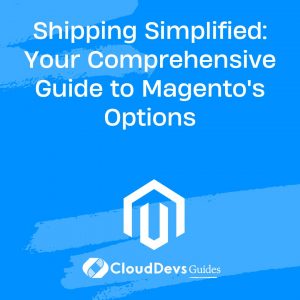Shipping Simplified: Your Comprehensive Guide to Magento’s Options
Magento, one of the most versatile e-commerce platforms available, is no stranger to the complexities of shipping and fulfillment. As any e-commerce store owner knows, shipping isn’t just about moving goods from Point A to Point B. It’s about ensuring customer satisfaction, managing costs, and optimizing operations. Let’s explore the shipping and fulfillment options available in Magento and provide real-world examples of how they can be utilized.
1. Flat Rate Shipping
Definition: This is a standard, fixed shipping charge that applies regardless of the size, weight, or quantity of the items.
Example: A jewelry store can use flat rate shipping for their products, given their small and consistent size. So, whether a customer orders a single ring or three necklaces, the shipping charge remains a flat $5.
2. Table Rate Shipping
Definition: Shipping cost is determined based on a combination of conditions, such as weight vs. destination, price vs. destination, or the number of items vs. destination.
Example: An apparel store may set up the following:
– For orders under $50: $5 shipping within the U.S, $10 to Canada, $20 international.
– For orders over $50 but under $100: Free shipping within the U.S, $8 to Canada, $15 international.
3. Free Shipping
Definition: No shipping charges applied. Often used as a promotional tactic or for orders exceeding a certain amount.
Example: An electronics retailer offers free shipping on all orders over $200, incentivizing customers to buy more.
4. Dimensional Weight Pricing
Definition: Shipping charges based on the volume or dimensional weight of a package, rather than its actual weight.
Example: A store selling stuffed toys might adopt dimensional weight pricing, as a large teddy bear, though light, would occupy more space in a shipping vehicle.
5. Real-time Carrier Rates
Definition: Live shipping rates fetched from carriers (like UPS, FedEx, etc.) based on the current rates they offer.
Example: A furniture store integrates with FedEx’s API. When a customer checks out with a coffee table, the store’s Magento setup calculates the shipping rate in real-time based on FedEx’s current charges for that table’s weight and dimensions.
6. In-store Pickup
Definition: Customers can order online and pick up their items at a physical store location, avoiding shipping costs.
Example: A chain of bookstores allows customers to order books online and then pick them up at their nearest branch.
7. Drop Shipping
Definition: Rather than keeping goods in stock, the store orders them from a third party (usually a wholesaler or manufacturer) which then ships directly to the customer.
Example: An e-commerce platform specializing in rare collectibles might not keep all items in stock due to storage costs. When a customer places an order, the store contacts its supplier, who then ships the collectible directly to the buyer.
8. Multi-Warehouse Shipping
Definition: For stores with multiple warehouses, Magento can decide from which warehouse to ship based on the customer’s location, stock availability, or other factors.
Example: A global cosmetics brand with warehouses in the U.S, Europe, and Asia will ship products to an Asian customer from its Asian warehouse to save on shipping time and costs.
9. Third-party Fulfillment Centers
Definition: Using services like Amazon FBA (Fulfillment By Amazon), where the inventory is stored in Amazon’s fulfillment centers, and they handle storage, packaging, and shipping.
Example: A startup board game company uses Amazon FBA for their flagship product, reducing the need for their own storage and shipping infrastructure.
10. Magento Extensions for Advanced Shipping
While Magento comes packed with robust shipping features, there are numerous extensions available to enhance and customize the shipping process further.
Example: The ‘Amasty Shipping Table Rates’ extension allows store owners to create an unlimited number of custom shipping methods, define shipping rates based on various parameters (like product attributes, shipping address, etc.), and provide multiple rates for different conditions.
Conclusion
The world of e-commerce shipping is vast, and Magento provides an array of options to tackle various shipping scenarios. Whether you’re a small boutique or a large multinational store, understanding and optimally configuring your Magento shipping settings is paramount to maintaining happy customers and a thriving online business. Remember, the right mix of shipping options can set your store apart, providing an edge in the highly competitive e-commerce landscape.
Table of Contents







